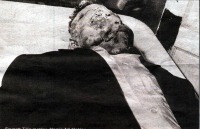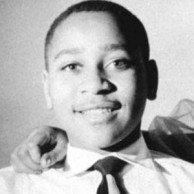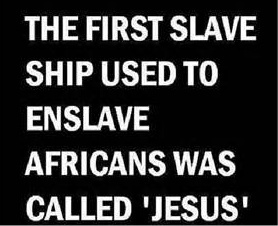 Throughout America’s sordid history, there have been many children murdered but the Murder in Money, Mississippi is the most infamous. It was this incident, the murder of a black child, fourteen year old Emmett Till that sparked the modern Civil Rights Movement. On August 28, 1955, Emmett Till, a fourteen-year-old black boy from Chicago supposedly whistled at a white woman in a grocery store.
Throughout America’s sordid history, there have been many children murdered but the Murder in Money, Mississippi is the most infamous. It was this incident, the murder of a black child, fourteen year old Emmett Till that sparked the modern Civil Rights Movement. On August 28, 1955, Emmett Till, a fourteen-year-old black boy from Chicago supposedly whistled at a white woman in a grocery store.
The crime sounded clarion calls for a nation to wake up – just look at the photo. Till’s mutilated corpse circulated around the country mainly because of John Johnson, who published the gruesome photographs in Jet magazine, a predominately African American publication. The photo drew intense public reaction.
Till didn’t understand or knew that he had broken an unwritten law of the Jim Crow South until three days later, when two white men dragged him from his bed in the dead of night, beat him brutally and then shot him in the head. That night the door to his grandfather’s house was thrown open, and Emmett was forced into a truck and driven away never again to be seen alive again. Till’s body was found swollen and disfigured in the Tallahatchie river three days after his abduction and only identified by his ring.
Till’s body was sent back to Chicago, where his mother insisted on leaving the casket open for the funeral and having people take photographs because she wanted people to see how badly Till’s body had been disfigured. This courageous mother was famously quoted as saying, “I wanted the world to see what they did to my baby” and over 50,000 people came to view the body.
On the day he was buried, two men — the husband of the woman who had been whistled at and his half brother — were indicted of his murder, but the all white male jury from Money (some of whom actually participated in Till’s torture and execution) took only an hour to return ‘not guilty’ verdict. The verdict would have been quicker, remarked the grinning foreman, if the jury hadn’t taken a break for a soft drink on the way to the deliberation room. To add insult to injury, knowing that they would not be retrial, the two accused men sold their stories to LOOK Magazine and gleefully admitted to everything.
Elsewhere in Mississippi at the time things weren’t going terribly well for blacks either. Just before Till was murdered, two activists Rev. George Lee and Lamar Smith were shot dead for trying to exercise their rights to vote, and in shocking testimony to the lack of law and order, no one came forward to testify although both murders were committed in broad daylight.
 The next year, a former army sergeant, Clyde Kennard, tried to enroll at Mississippi South College in Hattiesburg and was sent away, but came back to ask again. For this ‘audacity’, university officials — not students, or mere citizens, but university officials — planted stolen liquor and a bag of stolen chicken feed in his car and had him arrested. Kennard died halfway into his seven year sentence.
The next year, a former army sergeant, Clyde Kennard, tried to enroll at Mississippi South College in Hattiesburg and was sent away, but came back to ask again. For this ‘audacity’, university officials — not students, or mere citizens, but university officials — planted stolen liquor and a bag of stolen chicken feed in his car and had him arrested. Kennard died halfway into his seven year sentence.
But times were slowly a-changing: Brown vs. Board of Education was decided in 1954. Three months after the Till murder Rosa Parks would refuse to move to the back of a bus in Montgomery, Alabama. Sit-ins and marches would follow, and soon the civil rights movement itself would be in full-swing. It’s been over sixty-years since the events of that fateful night, and I simply cannot find the words to describe this heinous crime that has yet to receive justice.
I’ll end by sharing these words by Maya Angelou: “History, despite its wrenching pain, cannot be unlived, but if faced with courage, need not be lived again.” And that’s my Thought Provoking Perspective…
Purchase “Just a Season” today !!!


 As white folk celebrated their holidays and honor the remembrance of the lies they told. Black people have many sad reminders of their dastardly deeds and we should never forget the evils they inflicted upon us either. Therefore, I thought I’d offer this reminder about our stolen past to which there was nothing more horrifying than the “Middle Passage”. Coincidentally, most of you don’t know that the first registered slave ship was named the “Good Ship Jesus”! The African has overcome some adversity since being stolen from Africa but none worse than the removal of the culture and spirituality the practiced.
As white folk celebrated their holidays and honor the remembrance of the lies they told. Black people have many sad reminders of their dastardly deeds and we should never forget the evils they inflicted upon us either. Therefore, I thought I’d offer this reminder about our stolen past to which there was nothing more horrifying than the “Middle Passage”. Coincidentally, most of you don’t know that the first registered slave ship was named the “Good Ship Jesus”! The African has overcome some adversity since being stolen from Africa but none worse than the removal of the culture and spirituality the practiced.






